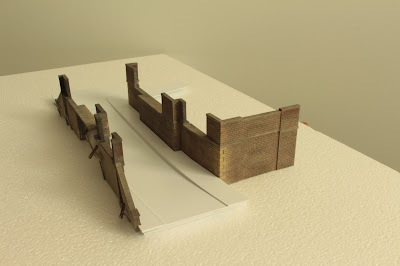 |
| Road below railway bridge and station car park |
The road and pavements including all the paving slabs were laser cut from white plastic and once assembled sprayed with two coats of grey plastic primer. A wash was then created from oil paints and white spirit which was then dabbed on with a make up brush. The road and pavement colour was created from a mix of grey and white with a little bit of yellow to warm the colour slightly. A very small amount of blue was also added for the road but not pavements.
 |
| Paint colours used |
After the wash had dried oil paints were then dry brushed on to provide some subtle weathering to the road and pavements surfaces. The paving slabs were also painted by a dry brush using a mix of grey, white and yellow.
The road markings were produced using a laser cut stencil.
 |
| Laser cut stencils |
The size and shape of the road markings were taking from the Traffic Signs Manual Chapter 5. The disabled sign and bus stop sign were imported into Corel Draw from the traffic sign manual and then scaled to the correct size. Other road markings were drawn based on the details in the manual.
 |
| Stencil used for road below bridge |
The bus stop stencil had to be created from two separate stencils as some plastic had to remain to hold the centre of the B, O, and P together. The holding plastic varied between the two stencils so that the full letters could be completed. The wheel for the disabled sign was also created from two stencils as the gap between the person and chair was so small it would not have been possible to laser cut this out. The edge of the stencils were designed so that they would fit against the paving slabs so consistent alignment between different stencils could be maintained.
 |
| Stencil used for car park |
The road markings were painted again using oil paints that had been allowed to dry over night. These were then dry brushed on through the stencil. it was very easy to apply too much paint through the stencil so a bit of practice was needed to get the correct amount of paint onto the road through the stencil.










